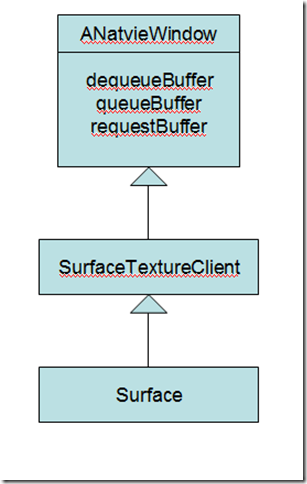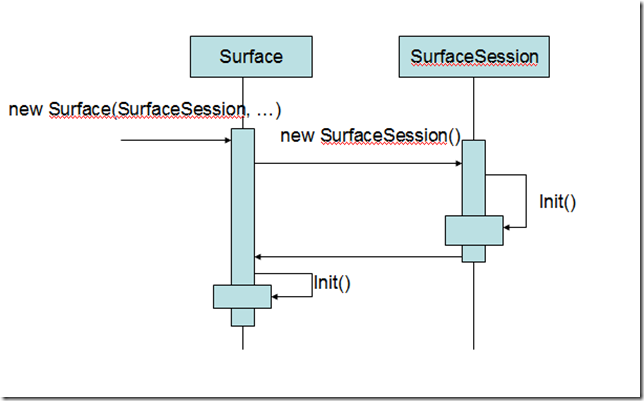Android4.0 Surface机制分析
1. java层面的Surface
对于Surface我们的认识主要是android的类Surface, android的文档描述Surface是“Handle onto a raw buffer that is being managed by the screen compositor”,这个描述透漏出两个信息:首先,Surface是一个raw buffer的句柄,通过它去管理一个raw buffer,其次,Surface本身是由screen compositor来管理的。但是raw buffer具体是什么,screen compositor又是什么,Surface是如何管理一个raw buffer,而它又是怎样被compositor来管理,后续我们会具体来分析。
Surface的具体使用上,我们通常并不直接去手动创建一个Surface,尽管可以这么做,通常,我们是通过SurfaceView,GLSurfaceView间接地去创建Surface,当然,更多的时候我们在使用Surface而不自知,在Andorid的窗口实现里,每一个Window其实都会对应一个Surface,而每个Activity都会持有一个Window,所以,我们通常在Activity里设置的view(通过setContentView),从java抽象上看其最终的绘制目标就是在Surface上。(Window以及view本身的结构也比较复杂,我会在后面的文章里再讨论这个部分。)
下面我们来看看Surface的接口都有什么,除了重要的构造函数外,比较重要的两个接口,lockCanvas, unlockCanvasAndPost. lockCanvas会返回一个Canvas给我们,我们可以使用这个Canvas来改变Surface的内容, 但是这个改变不会立刻生效,只有在我们调用了unlockCanvasAndPost之后,改变才会生效。
上面说了,通常我们并不手动去创建Surface,帮我们创建Surface的是WindowManagerService,它在帮我们创建Surface时,会生成一个SurfaceSession,然后将这个SurfaceSession作为参数来构造Surface。SurfaceSession,其代表的是与前面说的compositor的一个会话连接。
2. 一些重要的类及关系介绍
在开始介绍cpp层面的Surface工作流程之前,我们先简要的介绍几个比较重要的类,因为Surface的机制抽象层级比较多,对基本类的功能有一个初步了解有助于我们更容易理解。
首先,需要说明的是,java层的Surface与cpp层的Surface并不相同,他们之间存在着关系,但并不是同一个抽象. 而cpp层里Surface与ISurface又是不同的抽象,切忌混为一谈。
我们知道,在android里大量的使用了CS模式,把一些功能做成服务Service,供各个客户端Client访问,而Client,Service都具有相同的接口,这样抽象掉了Client,Service之间的通信,让Client,Service各自独立,消除耦合。对于Surface部分来说,Android的framework里主要涉及到以下的几个接口:

SurfaceFinger:这个是Surface服务端的总管家,它具体是ISurfaceComposer接口的服务端实现。
ComposerService:这个是为客户端取得ISurfaceComposer代理而提供的方便类。
ISurfaceComposer:通过这个接口可以访问到SurfaceFlinger,可以通过它建立一个会话,即ISurfaceComposerClient,也可以通过它去更新Surface的相关信息,这个是通过setTransactionState接口完成的。
SurfaceFlinger::Client: ISurfaceComposerClient的服务端实现。
SurfaceComposerClient: 持有ISurfaceComposerClient的客户端代理,在SurfaceComposerClient初次实例化时,通过ISurfaceComposer的createConnection()接口得到一个ISurfaceComposerClient的代理。同时,它也会管理Surface的状态,通过ISurfaceComposer更新Surface状态,状态的具体保存涉及到一个相关类Composer。可以说,它是Surface跟服务端打交道一个非常重要的接口。
ISurfaceComposerClient:代表一个到SurfaceFinger的会话连接。
SurfaceControl:从字面上看,其作用是控制Surface。其实际作用是持有ISurface的代理及SurfaceComposerClient
ISurfaceTexture:其对应具体的buffer管理
SurfaceTextureClient: 持有ISurfaceTexture的本地代理,通过它可以访问到ISurfaceTexture的实现。同时,特别注意的是,它继承了ANativeWindow,而Surface类会继承SurfaceTextureClient. ANativeWindow代表的是本地窗口,在创建EGL的eglSurface时需要用到它。
3. cpp层面的Surface
从前面的图中可见,在Surface及SurfaceSession的构造过程中,都会调用到各自的init方法,而init的具体实现是在cpp层,具体对framework/base/core/jni/android_view_Surface.java.
我们来看看这两个init的代码:
static void SurfaceSession_init(JNIEnv* env, jobject clazz)
{
sp<SurfaceComposerClient> client = new SurfaceComposerClient;
client->incStrong(clazz);
env->SetIntField(clazz, sso.client, (int)client.get());
}
.csharpcode, .csharpcode pre
{
font-size: small;
color: black;
font-family: consolas, "Courier New", courier, monospace;
background-color: #ffffff;
/*white-space: pre;*/
}
.csharpcode pre { margin: 0em; }
.csharpcode .rem { color: #008000; }
.csharpcode .kwrd { color: #0000ff; }
.csharpcode .str { color: #006080; }
.csharpcode .op { color: #0000c0; }
.csharpcode .preproc { color: #cc6633; }
.csharpcode .asp { background-color: #ffff00; }
.csharpcode .html { color: #800000; }
.csharpcode .attr { color: #ff0000; }
.csharpcode .alt
{
background-color: #f4f4f4;
width: 100%;
margin: 0em;
}
.csharpcode .lnum { color: #606060; }
SurfaceSession的init方法SurfaceSession_init主要是获取到一个SurfaceComposerClient,这个类是非常重要的与服务端通讯的类,它的作用:
- 通过在构造函数里使用ISurfaceComposer的createConnection接口,它获得ISurfaceComposerClient的本地代理
- 通过得到的ISurfaceComposerClient创建或销毁ISurface
- 通过它持有的Composer来记录Surface的状态,并在Composer里通过ISurfaceComposer接口更新状态。
static void Surface_init(
JNIEnv* env, jobject clazz,
jobject session,
jint, jstring jname, jint dpy, jint w, jint h, jint format, jint flags)
{
if (session == NULL) {
doThrowNPE(env);
return;
}
SurfaceComposerClient* client =
(SurfaceComposerClient*)env->GetIntField(session, sso.client);
sp<SurfaceControl> surface;
if (jname == NULL) {
surface = client->createSurface(dpy, w, h, format, flags);
} else {
const jchar* str = env->GetStringCritical(jname, 0);
const String8 name(str, env->GetStringLength(jname));
env->ReleaseStringCritical(jname, str);
surface = client->createSurface(name, dpy, w, h, format, flags);
}
if (surface == 0) {
jniThrowException(env, OutOfResourcesException, NULL);
return;
}
setSurfaceControl(env, clazz, surface);
}
.csharpcode, .csharpcode pre
{
font-size: small;
color: black;
font-family: consolas, "Courier New", courier, monospace;
background-color: #ffffff;
/*white-space: pre;*/
}
.csharpcode pre { margin: 0em; }
.csharpcode .rem { color: #008000; }
.csharpcode .kwrd { color: #0000ff; }
.csharpcode .str { color: #006080; }
.csharpcode .op { color: #0000c0; }
.csharpcode .preproc { color: #cc6633; }
.csharpcode .asp { background-color: #ffff00; }
.csharpcode .html { color: #800000; }
.csharpcode .attr { color: #ff0000; }
.csharpcode .alt
{
background-color: #f4f4f4;
width: 100%;
margin: 0em;
}
.csharpcode .lnum { color: #606060; }
sp<SurfaceControl> SurfaceComposerClient::createSurface(
const String8& name,
DisplayID display,
uint32_t w,
uint32_t h,
PixelFormat format,
uint32_t flags)
{
sp<SurfaceControl> result;
if (mStatus == NO_ERROR) {
ISurfaceComposerClient::surface_data_t data;
sp<ISurface> surface = mClient->createSurface(&data, name,
display, w, h, format, flags);
if (surface != 0) {
result = new SurfaceControl(this, surface, data);
}
}
return result;
}
.csharpcode, .csharpcode pre
{
font-size: small;
color: black;
font-family: consolas, "Courier New", courier, monospace;
background-color: #ffffff;
/*white-space: pre;*/
}
.csharpcode pre { margin: 0em; }
.csharpcode .rem { color: #008000; }
.csharpcode .kwrd { color: #0000ff; }
.csharpcode .str { color: #006080; }
.csharpcode .op { color: #0000c0; }
.csharpcode .preproc { color: #cc6633; }
.csharpcode .asp { background-color: #ffff00; }
.csharpcode .html { color: #800000; }
.csharpcode .attr { color: #ff0000; }
.csharpcode .alt
{
background-color: #f4f4f4;
width: 100%;
margin: 0em;
}
.csharpcode .lnum { color: #606060; }
sp<Surface> SurfaceControl::getSurface() const
{
Mutex::Autolock _l(mLock);
if (mSurfaceData == 0) {
sp<SurfaceControl> surface_control(const_cast<SurfaceControl*>(this));
mSurfaceData = new Surface(surface_control);
}
return mSurfaceData;
}
.csharpcode, .csharpcode pre
{
font-size: small;
color: black;
font-family: consolas, "Courier New", courier, monospace;
background-color: #ffffff;
/*white-space: pre;*/
}
.csharpcode pre { margin: 0em; }
.csharpcode .rem { color: #008000; }
.csharpcode .kwrd { color: #0000ff; }
.csharpcode .str { color: #006080; }
.csharpcode .op { color: #0000c0; }
.csharpcode .preproc { color: #cc6633; }
.csharpcode .asp { background-color: #ffff00; }
.csharpcode .html { color: #800000; }
.csharpcode .attr { color: #ff0000; }
.csharpcode .alt
{
background-color: #f4f4f4;
width: 100%;
margin: 0em;
}
.csharpcode .lnum { color: #606060; }
而Surface_init主要是通过SurfaceComposerClient获取了一个sp<SurfaceControl>,SurfaceControl是对ISurface及Surface的一层封装,其需要注意的地方是:
- 通过构造SurfaceControl时传入ISurface,其持有ISurface接口
- 它的getSurface方法可以构造一个Surface对象,并通过mSurfaceData持有Surface对象
- 它可以通过SurfaceComposerClient去更改Surface的状态
通过上面的分析我们得到了两个Surface,sp<ISurface>, sp<Surface>,前者,我们知道是ISurface的本地代理,但是Surface是做什么的呢,我们下面将具体分析Surface。
4. Surface对象
前面我们提到SurfaceControl的getSurface方法会构造一个Surface对象,事实上,Surface是我们Android GUI系统的核心部分,我们来看看代码:
Surface::Surface(const sp<SurfaceControl>& surface)
: SurfaceTextureClient(),
mSurface(surface->mSurface),
mIdentity(surface->mIdentity)
{
sp<ISurfaceTexture> st;
if (mSurface != NULL) {
st = mSurface->getSurfaceTexture();
}
init(st);
}
void Surface::init(const sp<ISurfaceTexture>& surfaceTexture)
{
if (mSurface != NULL || surfaceTexture != NULL) {
LOGE_IF(surfaceTexture==0, "got a NULL ISurfaceTexture from ISurface");
if (surfaceTexture != NULL) {
setISurfaceTexture(surfaceTexture);
setUsage(GraphicBuffer::USAGE_HW_RENDER);
}
DisplayInfo dinfo;
SurfaceComposerClient::getDisplayInfo(0, &dinfo);
const_cast<float&>(ANativeWindow::xdpi) = dinfo.xdpi;
const_cast<float&>(ANativeWindow::ydpi) = dinfo.ydpi;
const_cast<uint32_t&>(ANativeWindow::flags) = 0;
}
}
.csharpcode, .csharpcode pre
{
font-size: small;
color: black;
font-family: consolas, "Courier New", courier, monospace;
background-color: #ffffff;
/*white-space: pre;*/
}
.csharpcode pre { margin: 0em; }
.csharpcode .rem { color: #008000; }
.csharpcode .kwrd { color: #0000ff; }
.csharpcode .str { color: #006080; }
.csharpcode .op { color: #0000c0; }
.csharpcode .preproc { color: #cc6633; }
.csharpcode .asp { background-color: #ffff00; }
.csharpcode .html { color: #800000; }
.csharpcode .attr { color: #ff0000; }
.csharpcode .alt
{
background-color: #f4f4f4;
width: 100%;
margin: 0em;
}
.csharpcode .lnum { color: #606060; }
可以看到,在构造函数里,通过ISurface接口的getSurfaceTexture,我们得到一个ISurfaceTexture的本地代理,在init里我们保存了该代理,即SurfaceTextureClient将持有ISurfaceTextureClient。
我们第一节里说java层面的Surface有两个接口,lockCanvas,unlockCanvasAndPost,我们来看看其底层实现是怎样的
const sp<Surface>& surface(getSurface(env, clazz));
........................................
status_t err = surface->lock(&info, &dirtyRegion);
static void Surface_unlockCanvasAndPost(
JNIEnv* env, jobject clazz, jobject argCanvas)
{
jobject canvas = env->GetObjectField(clazz, so.canvas);
if (env->IsSameObject(canvas, argCanvas) == JNI_FALSE) {
doThrowIAE(env);
return;
}
const sp<Surface>& surface(getSurface(env, clazz));
if (!Surface::isValid(surface))
return;
// detach the canvas from the surface
SkCanvas* nativeCanvas = (SkCanvas*)env->GetIntField(canvas, no.native_canvas);
int saveCount = env->GetIntField(clazz, so.saveCount);
nativeCanvas->restoreToCount(saveCount);
nativeCanvas->setBitmapDevice(SkBitmap());
env->SetIntField(clazz, so.saveCount, 0);
// unlock surface
status_t err = surface->unlockAndPost();
if (err < 0) {
doThrowIAE(env);
}
}
.csharpcode, .csharpcode pre
{
font-size: small;
color: black;
font-family: consolas, "Courier New", courier, monospace;
background-color: #ffffff;
/*white-space: pre;*/
}
.csharpcode pre { margin: 0em; }
.csharpcode .rem { color: #008000; }
.csharpcode .kwrd { color: #0000ff; }
.csharpcode .str { color: #006080; }
.csharpcode .op { color: #0000c0; }
.csharpcode .preproc { color: #cc6633; }
.csharpcode .asp { background-color: #ffff00; }
.csharpcode .html { color: #800000; }
.csharpcode .attr { color: #ff0000; }
.csharpcode .alt
{
background-color: #f4f4f4;
width: 100%;
margin: 0em;
}
.csharpcode .lnum { color: #606060; }
首先,我们说Surface是一个ANativeWindow,它的继承关系如下:

ANativeWindow我们前面说过,它其实是一个EGL可以操作的窗口,其具体定义在system/core/include/system/window.h里,它的主要接口有dequeueBuffer,queueBuffer,lockBuffer等。
好了,搞清楚Surface是个什么东西,下面来看其lock及unlockAndPost方法:
status_t Surface::lock(SurfaceInfo* other, Region* inOutDirtyRegion) {
ANativeWindow_Buffer outBuffer;
ARect temp;
ARect* inOutDirtyBounds = NULL;
if (inOutDirtyRegion) {
temp = inOutDirtyRegion->getBounds();
inOutDirtyBounds = &temp;
}
status_t err = SurfaceTextureClient::lock(&outBuffer, inOutDirtyBounds);
if (err == NO_ERROR) {
other->w = uint32_t(outBuffer.width);
other->h = uint32_t(outBuffer.height);
other->s = uint32_t(outBuffer.stride);
other->usage = GRALLOC_USAGE_SW_READ_OFTEN | GRALLOC_USAGE_SW_WRITE_OFTEN;
other->format = uint32_t(outBuffer.format);
other->bits = outBuffer.bits;
}
if (inOutDirtyRegion) {
inOutDirtyRegion->set( static_cast<Rect const&>(temp) );
}
return err;
}
.csharpcode, .csharpcode pre
{
font-size: small;
color: black;
font-family: consolas, "Courier New", courier, monospace;
background-color: #ffffff;
/*white-space: pre;*/
}
.csharpcode pre { margin: 0em; }
.csharpcode .rem { color: #008000; }
.csharpcode .kwrd { color: #0000ff; }
.csharpcode .str { color: #006080; }
.csharpcode .op { color: #0000c0; }
.csharpcode .preproc { color: #cc6633; }
.csharpcode .asp { background-color: #ffff00; }
.csharpcode .html { color: #800000; }
.csharpcode .attr { color: #ff0000; }
.csharpcode .alt
{
background-color: #f4f4f4;
width: 100%;
margin: 0em;
}
.csharpcode .lnum { color: #606060; }
status_t Surface::unlockAndPost() {
return SurfaceTextureClient::unlockAndPost();
}
这两个方法都会调用到SurfaceTextureClient里的相应方法,代码这里就不贴了,lock的实现主要是dequeueBuffer出一个GraphicBuffer,而unlockAndPost主要是将这个GraphicBuffer入队queueBuffer。我们来看看SurfaceTextureClient的dequeueBuffer及queueBuffer实现:
int SurfaceTextureClient::dequeueBuffer(android_native_buffer_t** buffer) {
LOGV("SurfaceTextureClient::dequeueBuffer");
Mutex::Autolock lock(mMutex);
int buf = -1;
status_t result = mSurfaceTexture->dequeueBuffer(&buf, mReqWidth, mReqHeight,
mReqFormat, mReqUsage);
if (result < 0) {
LOGV("dequeueBuffer: ISurfaceTexture::dequeueBuffer(%d, %d, %d, %d)"
"failed: %d", mReqWidth, mReqHeight, mReqFormat, mReqUsage,
result);
return result;
}
sp<GraphicBuffer>& gbuf(mSlots[buf]);
if (result & ISurfaceTexture::RELEASE_ALL_BUFFERS) {
freeAllBuffers();
}
if ((result & ISurfaceTexture::BUFFER_NEEDS_REALLOCATION) || gbuf == 0) {
result = mSurfaceTexture->requestBuffer(buf, &gbuf);
if (result != NO_ERROR) {
LOGE("dequeueBuffer: ISurfaceTexture::requestBuffer failed: %d",
result);
return result;
}
}
*buffer = gbuf.get();
return OK;
}
.csharpcode, .csharpcode pre
{
font-size: small;
color: black;
font-family: consolas, "Courier New", courier, monospace;
background-color: #ffffff;
/*white-space: pre;*/
}
.csharpcode pre { margin: 0em; }
.csharpcode .rem { color: #008000; }
.csharpcode .kwrd { color: #0000ff; }
.csharpcode .str { color: #006080; }
.csharpcode .op { color: #0000c0; }
.csharpcode .preproc { color: #cc6633; }
.csharpcode .asp { background-color: #ffff00; }
.csharpcode .html { color: #800000; }
.csharpcode .attr { color: #ff0000; }
.csharpcode .alt
{
background-color: #f4f4f4;
width: 100%;
margin: 0em;
}
.csharpcode .lnum { color: #606060; }
int SurfaceTextureClient::queueBuffer(android_native_buffer_t* buffer) {
LOGV("SurfaceTextureClient::queueBuffer");
Mutex::Autolock lock(mMutex);
int64_t timestamp;
if (mTimestamp == NATIVE_WINDOW_TIMESTAMP_AUTO) {
timestamp = systemTime(SYSTEM_TIME_MONOTONIC);
LOGV("SurfaceTextureClient::queueBuffer making up timestamp: %.2f ms",
timestamp / 1000000.f);
} else {
timestamp = mTimestamp;
}
int i = getSlotFromBufferLocked(buffer);
if (i < 0) {
return i;
}
status_t err = mSurfaceTexture->queueBuffer(i, timestamp,
&mDefaultWidth, &mDefaultHeight, &mTransformHint);
if (err != OK) {
LOGE("queueBuffer: error queuing buffer to SurfaceTexture, %d", err);
}
return err;
}
.csharpcode, .csharpcode pre
{
font-size: small;
color: black;
font-family: consolas, "Courier New", courier, monospace;
background-color: #ffffff;
/*white-space: pre;*/
}
.csharpcode pre { margin: 0em; }
.csharpcode .rem { color: #008000; }
.csharpcode .kwrd { color: #0000ff; }
.csharpcode .str { color: #006080; }
.csharpcode .op { color: #0000c0; }
.csharpcode .preproc { color: #cc6633; }
.csharpcode .asp { background-color: #ffff00; }
.csharpcode .html { color: #800000; }
.csharpcode .attr { color: #ff0000; }
.csharpcode .alt
{
background-color: #f4f4f4;
width: 100%;
margin: 0em;
}
.csharpcode .lnum { color: #606060; }
我们可以看到,SurfaceTexture会利用持有的ISurfaceTextureClient接口去得到或入队GraphicBuffer。
我们前面也说过,Surface是一个ANativeWindow,而ANatvieWidnow是一个EGL可以操作的窗口,所以除了在java层显式调用lockCanvas方法可以操作Surface外,openGL ES通过EGL也能操作Surface。
5. GraphicBuffer
在具体分析之前,我们先来看一个ANativeWindow的dequeueBuffer以及queueBuffer原型:
int (*dequeueBuffer)(struct ANativeWindow* window,
struct ANativeWindowBuffer** buffer);
int (*queueBuffer)(struct ANativeWindow* window,
struct ANativeWindowBuffer* buffer);
.csharpcode, .csharpcode pre
{
font-size: small;
color: black;
font-family: consolas, "Courier New", courier, monospace;
background-color: #ffffff;
/*white-space: pre;*/
}
.csharpcode pre { margin: 0em; }
.csharpcode .rem { color: #008000; }
.csharpcode .kwrd { color: #0000ff; }
.csharpcode .str { color: #006080; }
.csharpcode .op { color: #0000c0; }
.csharpcode .preproc { color: #cc6633; }
.csharpcode .asp { background-color: #ffff00; }
.csharpcode .html { color: #800000; }
.csharpcode .attr { color: #ff0000; }
.csharpcode .alt
{
background-color: #f4f4f4;
width: 100%;
margin: 0em;
}
.csharpcode .lnum { color: #606060; }
参考文章:
http://www.linuxidc.com/Linux/2012-03/55898p7.htm
Android4.0 Surface机制分析的更多相关文章
- Android4.0窗口机制和创建过程分析
一 前言 在谈到这个话题的时候,脑海里面千头万绪,因为它涉及到了方方面面的知识… 比如Activity管理,窗口添加,Token权限验证等等… 既然这么复杂,那么我们就复杂的问题简单化,可以分成下面 ...
- Android系统Surface机制的SurfaceFlinger服务的线程模型分析
文章转载至CSDN社区罗升阳的安卓之旅,原文地址:http://blog.csdn.net/luoshengyang/article/details/8062945 在前面两篇文章中,我们分析了Sur ...
- Android系统Surface机制的SurfaceFlinger服务对帧缓冲区(Frame Buffer)的管理分析
文章转载至CSDN社区罗升阳的安卓之旅,原文地址:http://blog.csdn.net/luoshengyang/article/details/8046659 在前文中,我们分析了Surface ...
- Solr4.8.0源码分析(19)之缓存机制(二)
Solr4.8.0源码分析(19)之缓存机制(二) 前文<Solr4.8.0源码分析(18)之缓存机制(一)>介绍了Solr缓存的生命周期,重点介绍了Solr缓存的warn过程.本节将更深 ...
- Solr4.8.0源码分析(18)之缓存机制(一)
Solr4.8.0源码分析(18)之缓存机制(一) 前文在介绍commit的时候具体介绍了getSearcher()的实现,并提到了Solr的预热warn.那么本文开始将详细来学习下Solr的缓存机制 ...
- Android4.0中蓝牙适配器state machine(状态机)的分析
今天晓东和大家来一起看一下Android4.0中蓝牙适配器(Bluetooth Adapter)的状态机变化的过程.首先,我们需要了解一下,蓝牙适配器究竟有哪些状态,从代码可以清晰地看到(framew ...
- Android4.0图库Gallery2代码分析(二) 数据管理和数据加载
Android4.0图库Gallery2代码分析(二) 数据管理和数据加载 2012-09-07 11:19 8152人阅读 评论(12) 收藏 举报 代码分析android相册优化工作 Androi ...
- Android4.0图库Gallery2代码分析(一) 程序整体结构
Android4.0图库Gallery2代码分析(一) 程序整体结构 Gallery2的用例图分析:Gallery2主要功能是实现本地存储器.MTP存储器和网络存储器中媒体(图像和视频)的浏览.显示和 ...
- Android4.0 Launcher拖拽原理分析
在Android4.0源码自带的Launcher中,拖拽是由DragController进行控制的. 1) 先来看看类之间的继承关系 2)再来看看Launcher拖拽流程的时序图 1.基本流程: ...
随机推荐
- python3----datetime模块分析
datetime模块用于是date和time模块的合集,datetime有两个常量,MAXYEAR和MINYEAR,分别是9999和1. datetime模块定义了5个类,分别是 1.datetime ...
- instance method '*****' not found (return type defaults to 'id')
博文转载至 http://blog.csdn.net/cerastes/article/details/38025801 return type defaultsnot foundiOSwarning ...
- NData转化
NSdata 与 NSString,Byte数组,UIImage 的相互转换---ios开发 Objective-C 1. NSData 与 NSStringNSData-> NSStringN ...
- IT 运行在云端,而云运行在 Linux 上
导读 IT 正在逐渐迁移到云端.那又是什么驱动了云呢?答案是 Linux. 当连微软的 Azure 都开始拥抱 Linux 时,你就应该知道这一切都已经改变了.不管你接不接受, 云正在接管 IT 已经 ...
- Linux中chown和chmod的区别和用法(转)
chmod修改第一列内容,chown修改第3.4列内容: chown用法: 用来更改某个目录或文件的用户名和用户组. chown 用户名:组名 文件路径(可以是绝对路径也可以是相对路径) 例1:cho ...
- WCF入门(十)——服务对象模型
当发生一次WCF请求-响应操作时,会经过如下几个步骤 WCF Client想WCF Server发送一个服务请求 WCF Server创建WCF服务对象 WCF Server调用WCF服务对象接口,将 ...
- selenium + chrome 被检测,反反爬小记
selenium + chrome 很多难以采集的网站都使用selenium爬取,但是后来发现selenium有特征值,会被检测出来,今天来小结一下反反爬方案 测试网站 全绿好像代表没被检测出 中间人 ...
- 安装mysql最后一步未响应,卡死。(解决方法mySql5.5,以及安装教程)
安装教程:http://www.server110.com/mysql/201308/784.html 重装mysql的时候,总是在提交配置后的最后一步,安装失败,进程管理器里显示程序无响应,mysq ...
- Python全栈day17(文件处理)
一,文件处理流程 打开文件,得到文件句柄并赋值给一个变量 通过句柄对文件进行操作 关闭文件 二,文件打开模式 r只读 (默认打开模式是只读) w只写 a追加 三,文件操作实例 1.r读 read读取文 ...
- Android中可自由移动悬浮窗口的实现
http://www.xsmile.net/?p=538 调用WindowManager,并设置WindowManager.LayoutParams的相关属性,通过WindowManager的ad ...

